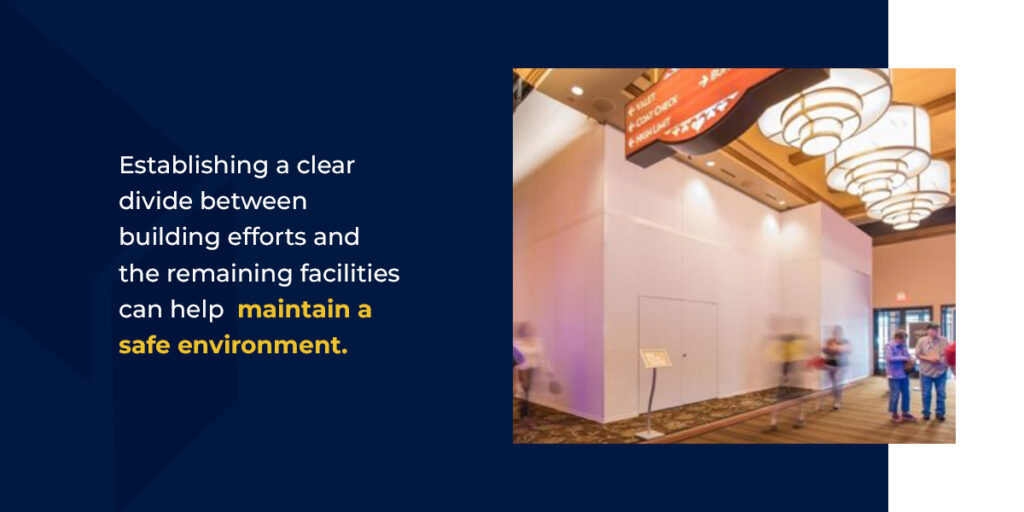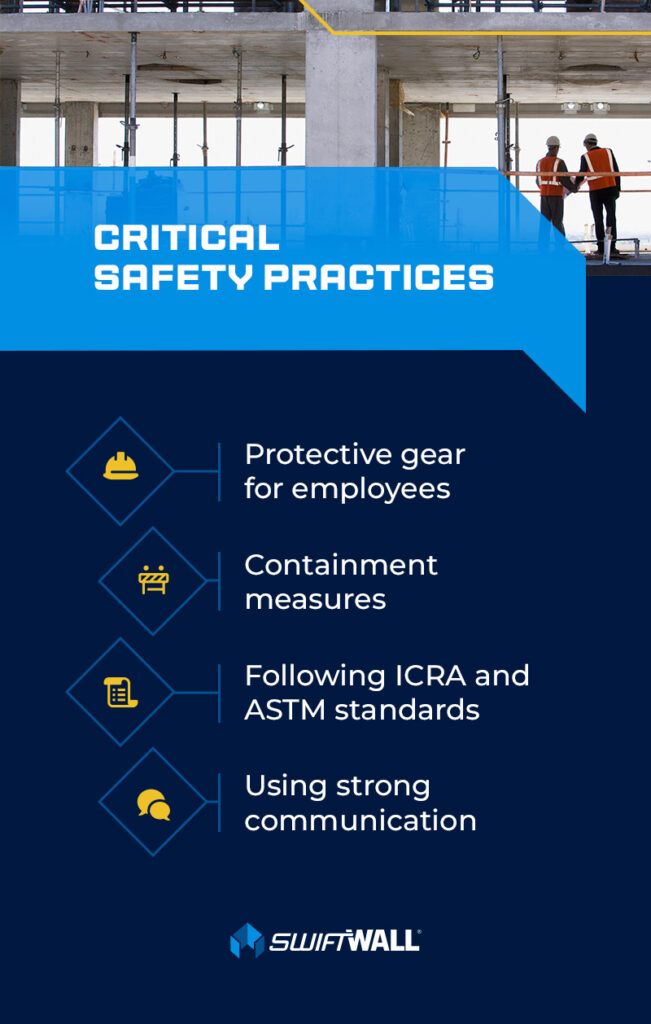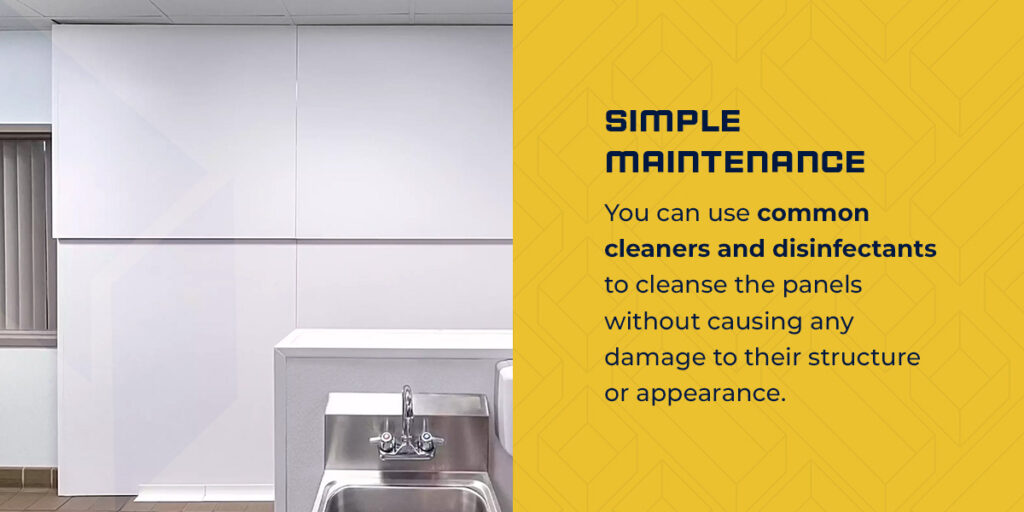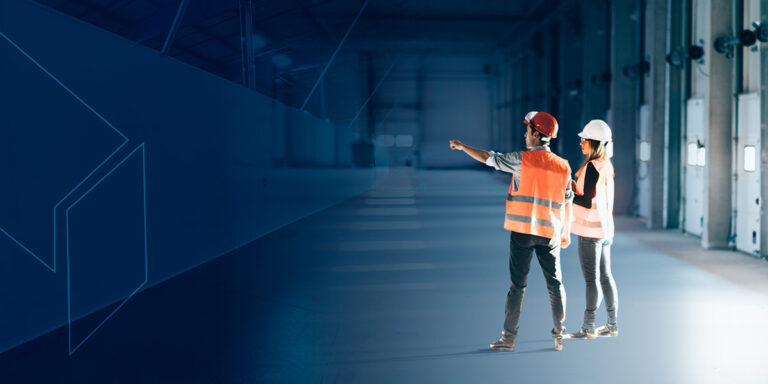Ways We Design for Safety in Our Walls
Businesses often invest in commercial renovations to upgrade their physical locations. From adding a new room to replacing a floor, these construction projects can help you deliver a more enhanced experience for customers and users.
Safety should be a top priority no matter what construction project you take on. If you schedule renovations during regular business hours, you need to follow proper safety procedures to keep customers safe.
While some sites use drywall to separate ongoing construction from other business procedures, temporary walls are a superior alternative. Temporary barriers have simple installation measures and key safety features. They can help maintain a safe construction environment while completing your project.
Read on to learn more about construction safety and how SwiftWall commits to safe wall design.
Common Challenges in Construction
Renovations and construction projects are common in most industries. Whether you manage a shopping mall or a school building, new construction can update your facilities and enhance user experience.
However, building projects can present challenges for businesses and other organizations. Many choose to keep up with regular operations during construction, so they won’t lose revenue or discontinue important services. But ongoing construction can lead to challenges with the following:
1. Maintaining Safety
It’s crucial to prioritize customer safety during construction. Renovations often require specialized equipment and procedures that only professional crews should handle. If you allow construction to occur during normal business procedures, keeping customers away from moving equipment and materials is vital.
Construction projects could create hazards like:
- Exposed electrical cords
- Tripping or falling hazards
- Exposure to airborne materials
Specific industries like healthcare require construction projects to meet certain standards. During renovations, the equipment can stir up dust and bacteria. These materials could reach patients and infect them if they aren’t properly restrained. The Centers for Disease Control and Prevention (CDC) mandates that the project must pass an Infection Control Risk Assessment (ICRA) if you complete renovations while around patients.
Establishing a clear divide between building efforts and the remaining facilities can help maintain a safe environment. For example, a dining establishment might want to build an additional dining area for its customers. They could bring in a construction crew to develop the new room but still allow regular customers to access the rest of the restaurant. To keep construction separate from the other customers, the restaurant could use a temporary wall divider.

2. Keeping Spaces Clean
Construction can also pose a challenge to cleanliness. No matter your industry, businesses need to maintain a clean environment for customers and users. From restaurants to malls, customers expect sanitary conditions. The cleaner your area is, the more satisfied your buyers become.
But depending on the size of your project, ongoing construction can make it more challenging to maintain a clean environment. Without proper separation, sawdust or drywall dust could reach other areas of your facility.
Your renovation project could also make organizing your location more difficult. You might have to block off certain entrances, exits or other important areas. As you make these changes, keeping everything organized might become more challenging. For instance, you might lose storage space or have to move tables together. A crowded area can become more challenging to clean or maintain.
3. Minimizing Distractions
Lastly, construction projects can create significant distractions for customers or other users in the building. For instance, they could cause disturbances like:
- Visual disruptions: Projects can display many images or other visual distractions for users. Many renovations need heavy machinery or equipment, which can take up large portions of space and distract customers. You might also have to block off certain areas during construction, which can disrupt your usual layout. Customers might be bothered by these variations and have a less positive experience.
- Loud noises: Construction can also cause noise disturbances. Drills, saws, jackhammers and similar tools create a clamor while in use. Consistent noises might make it harder for customers to communicate clearly with employees. Loud noises can also cause headaches or frustration, lowering customer satisfaction. Many businesses try to schedule noisier construction for times of low traffic or outside regular business hours.
Too many distractions can prevent customers from enjoying services or products. It’s important to regulate construction so it doesn’t impact overall customer satisfaction. If your renovations are extensive, you could consider closing for a short period to complete them. However, most companies don’t want to lose revenue due to a shutdown.
Businesses often choose tools like temporary walls to minimize disturbances and remain open. These tools can hide construction equipment and progress from customers. Some temporary barriers even have sound-proofing capabilities to limit equipment noises.
The Importance of Safety and Construction Containment
Once you commit to a renovation, your facilities have extra safety considerations. Whether you replace ceiling tiles or remove an entire wall, safety is the most critical feature of your construction project. Construction sites must follow the correct procedures to keep employees and passersby safe.
Critical safety practices include:
- Protective gear for employees: Providing protective gear for regular building employees can protect them from potential construction hazards. For instance, earplugs could block out excessive noise from nearby machines and shield their ears. You could also give them masks or other personal gear to maintain their safety. In addition, all construction workers must wear the correct personal protective equipment necessary for the specific project.
- Containment measures: Knowing how to contain construction zones in buildings is crucial. Containment is the process of separating construction work from ongoing building operations. These divisions are especially crucial in healthcare facilities, where direct exposure to dust could cause illness. Project managers often use materials like drywall or plastic sheets for containment measures. However, temporary walls are a safe drywall alternative for project containment. These barriers are simple to install and don’t produce excess dust like drywall.
- Following ICRA and ASTM standards: Construction projects should also follow regulations set by the ICRA and ASTM International. These standards set specific safety guidelines for different materials and situations. The ICRA provides guidelines for renovation projects with infection risks, such as nearby patients. The ASTM gives standards for meeting flame resistance and spreading smoke in case of a fire. As you plan your construction, ensure the project follows these standards.
- Using strong communication: Consistent communication can also prepare users for upcoming construction. In turn, they can take the necessary precautions while in the building. For instance, you could send messages and use physical signs to alert people of ongoing construction. Sending emails or text messages to regular customers will inform them of your renovation plans, so they can adjust expectations before visiting. You can also use signs to point toward construction areas or signal alternative entrances for users. These communication measures can add to the safety of your facility.

Following safety techniques like these can protect customers and employees during your renovations.
4 Ways That SwiftWall® Incorporates Safety in Our Wall Design
SwiftWall is a leading manufacturer of reusable, temporary walls. We design, manufacture and test various barrier solutions to suit project needs. Our modular wall systems are safe options for construction work.
Safety is an essential feature of our design. We manufacture durable and secure materials that help maintain a safe environment. Here are four ways we incorporate safety into our wall designs:
1. Easy Assembly Design
We manufactured our SwiftWall temporary barriers for simple installations. The easy assembly allows employees to set them up safely and quickly, limiting injuries during construction. In contrast, materials like drywall can have lengthy and complicated setup procedures. You have to use frame a wall, then cover it with drywall, which can take days. Our walls feature a simple installation that one person can complete in hours, depending on the height and complexity of the project.
We deliver our SwiftWall systems in pre-finished configurations, making it simple for you to finalize your setup. In addition, we provide detailed instructions for installation that guide you through each step. And even after you assemble them, their design allows for quick reconfiguration and removal.
Our SwiftWall Flex option also has adjustability features. The sliding top panel allows you to adjust these wall panels by up to 2.5 feet in length so you can meet your project’s specific height or ceiling requirements. And if your renovation needs change, you can easily alter the panels by sliding rather than cutting or damaging materials.
With SwiftWall’s simple installation, you can keep employees and customers safe during construction. Employees can quickly place the panels and stay protected as they do. You can install our wall systems up to five times faster than typical drywall. You won’t encounter excess dust from drywall, and you can get started with your renovations in just a few hours. You also limit disruptions for ongoing business operations.
2. Meeting ICRA Standards
If you’re in the healthcare industry, you must meet the ICRA requirements for hospital construction. These guidelines prevent environment-associated infections that could occur due to ongoing construction. At SwiftWall, we understand the importance of construction safety in patient-based settings. Our temporary wall systems meet and exceed all ICRA Class IV requirements, making them safe options for your healthcare projects.
Our designs have protective features that make them safe for healthcare settings, such as:
- Closed-cell foam core: With our closed-cell foam core construction, all pores and cells of the wall are sealed off to the outside. This design inhibits the movement of dust or other harmful bacteria.
- Simple maintenance: Surfaces in healthcare require regular disinfection and maintenance. SwiftWall temporary walls are easy to clean with their solid surfaces. You can use common cleaners and disinfectants to cleanse the panels without causing any damage to their structure or appearance. Staff can wash the temporary walls regularly, maintaining a clean environment.
- Non-microbial materials: All our walls consist of non-microbial materials. These offer protection against bacteria, mold, mildew and other harmful microbes. You can reduce microbe formation and keep your healthcare facility safe.

Overall, all of our temporary barriers meet the necessary ICRA requirements for safety. You can use them in a wide range of healthcare renovation projects.
3. Ongoing Testing
We are leading manufacturers of temporary walls and know the importance of safe and durable materials. While we design and construct our products, we use thorough testing to ensure they meet safety requirements. Through these measurements, we ensure our wall systems are safe to use and fit for extended applications.
Our tests measure capabilities like:
- Durability
- Installation
- Adjustability
- Smoke spreading
- All components of an ICRA
In addition, we’re always brainstorming new ways to upgrade our products. For instance, our newest product SwiftWall Flex was designed with simple height adjustment capability. We’re constantly looking for ways to make space transformation exciting.
4. Use of Sustainable Materials
Lastly, SwiftWall is also committed to sustainability. Using sustainable materials can help you create a safe environment in your workspace and the world. SwiftWall exists for the sustainable creation of space and strives to find ways for consumers to reduce, reuse and recycle in a close-looped system.
We apply three environmental strategies to our manufacturing:
- Reduce: Choosing SwiftWall products over drywall or other materials can reduce landfill waste by 100%. SwiftWall products are highly durable, creating a more impact-resistant solution than standard drywall. In turn, you can use SwiftWall materials for longer periods and reduce the need for replacements. In addition, SwiftWall offers used products to reduce waste further. Used products lower emissions from creating new materials and landfill disposals.
- Reuse: Reusing items and materials is an essential part of waste management. You can reuse SwiftWall products almost endlessly. With their easy reconfiguration, you can use our wall systems repeatedly in different construction projects. Or, you can repurpose them to meet different needs. SwiftWall panels are a clean and fast alternative to drywall, which is typically single-use only. Regular reusing also saves you additional replacement costs, often reducing costs by 80% over five uses.
- Recycle: SwiftWall also integrates the practice of recycling into daily procedures. After use or if damage occurs to the SwiftWall products, SwiftWall will collect the items and reuse them in their manufacturing process. The items get recycled into new products, extending their life spans. SwiftWall also uses sustainable methods during construction. The manufacturing process minimizes waste and uses environmentally friendly materials in all panels.
Overall, SwiftWall temporary walls are safe for any construction application and have little environmental impact. We commit to environmental and site safety with each of our products and are proud to offer a safe and clean alternative to drywall.
Contact SwiftWall® Today

Safety procedures are essential for construction projects. Whether you’re fixing a few floor tiles or replacing an entire ceiling, your team needs to follow the correct methods.
If you’re ready to invest in a temporary wall solution and need a fast, sustainable alternative to drywall, choose SwiftWall today. Our temporary wall systems include:
- SwiftWall Pro: SwiftWall Pro provides a comprehensive wall solution. It features durable panels, channels and rails that complete a wall system. Its durability and easy assembly make it an excellent option for many construction projects.
- SwiftWall Flex: SwiftWall Flex focuses on flexibility with the added adjustability feature. You can customize and reconfigure your wall system to meet various ceiling heights.
- SwiftWall Max: SwiftWall Max offers a sleek design and maximum durability. It meets Class A fire ratings and has a wear-resistant finish. You can interlock the panels to heights of up to 30 feet.
- SwiftWall Lite: SwiftWall Lite is our lightest and most economical option. It’s a quick solution for smaller projects and is extremely easy to handle and install.
Get started with SwiftWall today by contacting us. We can help you find the best wall system for your specific project.

